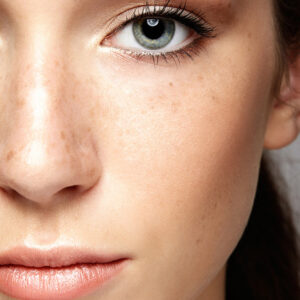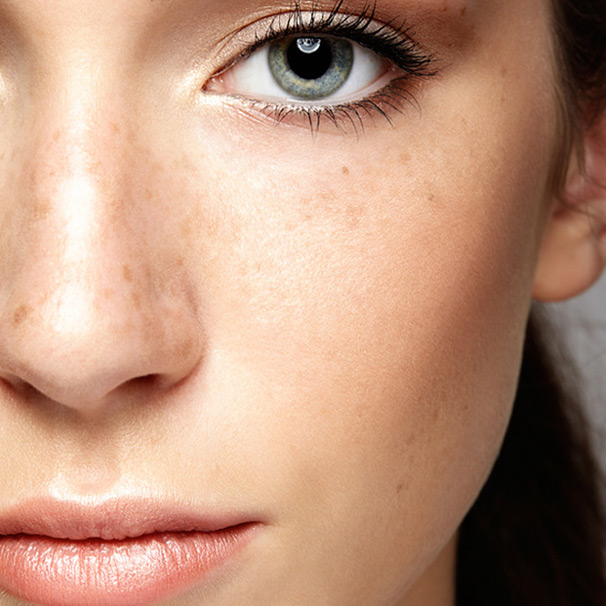Skin Bleaching
Everyone wants to have an even, smooth skin tone. Being plagued by dark spots - whether large or small, is a definite cosmetic no-no. But bleaching and whitening options have become so complicated it practically takes a degree to understand how to make the proper selection and arrange them into an effective routine. Here's what you can do to reclaim a clear, glowing complexion.
Why Do I Have Skin Discoloration?
There's more than one cause of skin discoloration. Fortunately, bleaching remains the same regardless of the source of the darkness.
The aftermath of skin inflammation is one common source of discoloration. Skin trauma, no matter how minor or severe can lead to cutaneous inflammation. A small blemish, a bug bite, chronic friction; they're all you need to leave skin irritated and ultimately discolored.
Once resolved, local pools of skin pigment remain. No one is exempt from this condition known as PIH (post inflammatory hyperpigmentation). However, your baseline skin tone ultimately dictates just how discolored the skin becomes. For instance, I have an olive skin tone, so for me PIH is often purplish or a faint light brown. The darker your skin tone, the darker the PIH will likely be. And the darker the PIH, the longer it will probably take to bleach things back to normal. Even purplish discoloration may take up to 6 months to resolve. Deeper, dark brown skin discoloration can take more than a year.
Melasma (aka the mask of pregnancy) is another common condition resulting in patchy skin discoloration. The hormone estrogen can at times result in overactive pigment producing melanocytes. The outcome is brown patches across the cheeks, chin, forehead and around the mouth. While you don't have to be taking supplemental estrogens or be pregnant to develop melasma, these certainly increase your risk.
Let's just be clear on one thing, the sun is your enemy. No matter the cause of your discoloration, the sun actively plays a role in deepening the disparity between your natural, lovely skin tone and the unwanted dark patches. Maybe you can place the blame squarely on all those hours spent intentionally sun bathing or perhaps you were merely passing through on your way to less sunny conditions. But without sunscreen, those UV rays are going to send your pigment-producing skin cells (aka melanocytes) into overdrive.
Bleaching Basics:
The good news for treating blotchy skin discoloration is that regardless of the cause; be it due to old acne, bug bites, skin trauma, underarm irritation, sun damage (such as freckles and "liver spots") or hormonal reasons (melasma); your bleaching basics remain the same.
It's important to understand bleaching terminology. Currently the FDA only recognizes hydroquinone as a "bleaching agent". That means that many other ingredients incorporated into products must be referred to as lighteners, brighteners or whiteners.
Bleaches should be applied ONLY to the dark spot. Select areas that are well defined to bleach. This can help improve the ultimate outcome. If you do not have well defined areas to bleach, or have widespread freckling, you will want to select a skin brightener that is safer to use in more widespread areas.
Avoid applying the bleaching product to normal surrounding skin. Continued use of the bleach on normal skin will slowly lighten the regular skin tone, too.
Sun protection is crucial, because like I said earlier, the sun is your enemy! The sun will try to darken up the areas you are working so hard to bleach. A broad-spectrum SPF 30 should be applied daily and can be applied on top of your chosen discoloration-busting treatment.
Bleaching is not a fast process. Depending upon how dark the area is compared to the normal skin tone, it can take as long as a year or sometimes even longer. Once the desired effects are achieved, bleaching should be stopped. Otherwise, you may end up with areas of the skin that are lighter than your normal skin tone!
A well-rounded bleaching regimen should not only eliminate excess pools of pigment; it should also prevent unwanted skin color (melanin) from being formed in the first place. As is always the case in medicine, the more points in the physiologic pathway you can disrupt, the better and often more rapid the improvement. The same goes for bleaching.
Skin pigment is ultimately produced based upon the actions of the enzyme tyrosinase which catalyzes the chemical production of melanin. Shut down tyrosinase activity and you prevent further discoloration from forming.
In the dark ages of bleaching, (no pun intended), single ingredient products ruled. Nowadays, when it comes to trying to lighten those bits of brown, "the more the merrier" is the bleaching mantra. Synergy of ingredient actions works to maximize results. You'll find many different ingredients used in nearly endless variations. These ingredients include:
Hydroquinone
Hydroquinone is just one of many agents capable of interfering with tyrosinase. It has come under fire for causing skin irritation, an unusual increased darkening of the treatment site known as ochronosis, and there have been stray concerns that it could lead to some sort of problem with fetal development. Hydroquinone has been reported to cause some mutations in lab research on Salmonella and hamsters. While considered to have a high safety rating here in the U.S., for these reasons, hydroquinone is unavailable for use as a bleaching agent in Europe and South Africa. As of now, the FDA stands behind hydroquinone and its safety record.
The general rule of thumb in this situation is to discontinue hydroquinone-based bleaches after 4-6 months if improvement is not seen.
If you're unable or unwilling to use hydroquinone, hauronoside and arbutin are both similar in structure to hydroquinone and help lighten skin without the associated risks of irritation, ochronosis or mutagenicity.
Mitracarpus Scaber Extract
Mitracarpus scaber extract is a botanically derived lightening agent from the leaves of a tropical plant. Like hydroquinone, it prevents the actions of tyrosinase circumventing melanin formation. The active ingredient found in mitracarpus scaber extract is harounoside, a derivative of hydroquinone. While chemically related to hydroquinone, mitracarpus scaber extract is less irritating and considered more effective in skin lightening.
Arctostaphylos Uva Ursi Leaf Extract
More commonly referred to as bearberry extract, the active agent is arbutin. The extract is created from leaves of the bearberry shrub. Another hydroquinone derivative, it inhibits tyrosinase activity and provides the same benefits while skipping hydroquinone concerns. Neither harounoside, nor arbutin break down into hydroquinone.
Dithiaoctanediol
Sugar free is one way to prevent melanin production. Preventing the chemical reaction in which a sugar molecule is added to tyrosinase inhibits enzymatic activation. Dithiaoctanediol is added to lightening treatments to attack the pigment forming pathway in this novel manner.
Beta Carotene
This photoprotection constituent of carrot oil reduces pigment formation by blocking tyrosinase receptors on the melanocyte. In doing so, the enzyme tyrosinase can't "turn on" the melanocyte to produce melanin.
Licorice Extract
The main active ingredient found in licorice extract for skin bleaching is glabridin. Glabridin inhibits pigmentation by preventing tyrosinase activation. It is nontoxic to melanocytes, preventing permanent discoloration nor is it toxic to surrounding keratinocytes. In fact, licorice extract has long been purported to have anti-inflammatory properties.
Gluconic Acid
Gluconic acid is a chelating agent, binding copper molecules necessary to activate the tyrosinase enzyme. Its addition to lightening treatments rounds out a bleaching product's effectiveness.
Azeleic Acid
Azeleic acid is derived as a naturally occurring byproduct of metabolism of the yeast pityrosporum ovale. Known for its use in acne therapy, dermatologists make use of its side effect: skin lightening. Azeleic acid selectively works on overactive melanocytes, rather than affecting normally pigmented skin.
Paper Mulberry
Paper mulberry is another botanical plant extract shown to inhibit tyrosinase activity. It is not considered an irritant and is often incorporated into skin lightening treatments.
Kojic acid
The end product of fungal metabolism, kojic acid inhibits tyrosinase activity. With long term exposure, melanocytes treated with kojic acid additionally lose their dendrites which reduces the ability of these cells from passing on any residual pigment onto the keratinocytes.
Melatonin
Not normally found in skin bleaching agents, melatonin has had anecdotal reports of lightening hair follicles. It's suggested that it may somehow affect cellular cyclic AMP rather than interfere with tyrosinase activity. Melatonin is secreted by the pineal gland in response to sunlight.
Vitamin C
Several forms of topical Vitamin C have been shown to reduce melanin formation. These include l-ascorbic acid, magnesium ascorbyl phosphate and sodium ascorbyl phosphate. Of course, these play an antioxidant role as well.
Alone, each of these ingredients have an assigned niche for mildly interfering with pigment production. Together, they can wreak havoc upon hyperactive melanocytes. The days of monotherapy in skin bleaching and brightening are over. Look for products, whether Rx or OTC that target the entire spectrum of melanin production.
Desquamating Discoloration Away
Preventing skin discoloration from forming in the first place is one part of the equation; the other, to eliminate undesirable uneven blotches already present. AHAs, BHA, retinoids and sutilains all work to exfoliate discolored cells, revealing the clear skin hidden underneath.
Tretinoin and Retinol
The active agent found in such medications as Retin A, Avita and Renova, tretinoin increases cellular turnover, expediting the exfoliation process and eliminating pigment already pooled in the epidermis. By increasing the rate of cellular turnover, melanocytes have less time to be able to pass melanosomes on to keratinocytes. For those unable to obtain a prescription, retinol remains a terrific alternative. Look for products such as DERMAdoctor Poetry in Lotion 1% Retinol that can speed up epidermal exfoliation. But remember, while it may say 1% Retinol rather than tretinoin on the ingredient label, retinols remain quite potent. Use with the same caution you would a prescription option or else you may find your skin rapidly becoming chapped and dry.
Glycolic acid
Alpha hydroxy acids expedite cellular exfoliation. Glycolic acid and lactic acid are the two most commonly used for this purpose. AHAs are frequently incorporated into a bleaching regimen.
Sutilains
A member of the keratase family which includes agents like papain, sutilains dissolve the intercellular cement, effectively dissolving the bonds which hold the cells together and easing the desquamation process. Sutilains also improve penetration of ingredients meant to reduce melanin production.
Here is the list of the multi-talented hydroquinone-based prescription players:
- Lustra- Contains 4% hydroquinone, 4% glycolic acid.
- Lustra AF - Contains 4% hydroquinone, 4% glycolic acid plus SPF 15.
- Alustra - Contains 4% hydroquinone and retinol.
- Glyquin - Contains 4% hydroquinone, 10% glycolic acid, SPF 15 and is sodium metabisulfite free.
- Tri-Luma - Contains 4% hydroquinone, 0.05% tretinoin and 0.01% fluocinolone acetonide (a potent steroid). Product must be discontinued after 8 weeks of use to prevent skin atrophy (thinning).
Peel Power
Exfoliation can be a useful tool in hastening the resolution of melasma. It works to remove superficial pigmented skin cells and also eases penetration of bleaching agents. A variety of means can be used, both mechanical and chemical. Whatever your weapon of choice, a fine line exists between exfoliation and excessive inflammation. The unwanted outcome of too much irritation can be an increase in skin pigmentation also known as post inflammatory hyperpigmentation.
Exfoliation with DERMAdoctor Physical Chemistry Facial Microdermabrasion and Multi-Acid Chemical Peel that incorporates both a chemical peel with microdermabrasion helps lift away pigment that has already risen toward the surface, hastening a more even complexion.
A final skin bleaching thought -- remember to stick with your program for the long haul. When you have achieved your desired results, stop your bleach but continue your sun protection.
Audrey Kunin, M.D.
This content is sponsored by DERMAdoctor. The author receives compensation for its creation. All content is the legal copyright of DERMAdoctor, Inc, and it may not be used, reprinted, or published without written consent. The information provided is for entertainment purposes only and is not intended to provide medical, legal or other professional advice.


